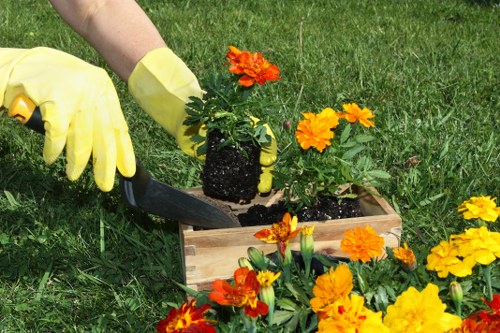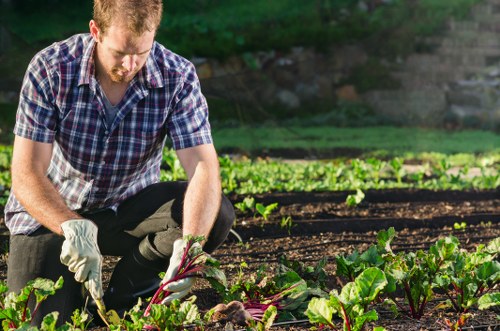Garden Clearance in Sanderstead
Why Garden Clearance is Essential

Maintaining a beautiful and functional garden requires regular upkeep, and one of the most crucial aspects of garden maintenance is garden clearance. Whether you're preparing your garden for a new season or reclaiming space for new plants, proper clearance can make a significant difference.
Garden clearance involves removing unwanted plants, debris, and overgrown vegetation. This process not only enhances the aesthetic appeal of your garden but also promotes a healthier environment for your plants to thrive.
In Sanderstead, where the climate and soil conditions can vary, regular garden clearance helps prevent the spread of diseases and pests, ensuring that your garden remains vibrant and lush throughout the year.
Benefits of Professional Garden Clearance

While some homeowners may attempt to clear their gardens themselves, hiring a professional garden clearance service in Sanderstead offers numerous advantages:
- Expertise: Professionals have the knowledge and experience to identify and remove invasive species effectively.
- Efficiency: A professional team can complete the clearance process quickly and efficiently, saving you time and effort.
- Safety: Garden clearance can involve handling heavy debris and potentially hazardous plants. Professionals are trained to manage these safely.
- Equipment: Access to specialized tools and machinery ensures that the clearance is thorough and effective.
By choosing a reputable garden clearance service in Sanderstead, you can ensure that your garden is cleared responsibly and sustainably.
Steps Involved in Garden Clearance

Garden clearance is a multi-step process that requires careful planning and execution. Here are the typical steps involved:
- Assessment: The first step is to assess the current state of your garden. This includes identifying areas that need clearance and determining the extent of the work required.
- Planning: Based on the assessment, a detailed plan is created. This plan outlines the tasks to be performed, the tools and equipment needed, and the timeline for completion.
- Removal of Debris: Fallen branches, old plant material, and other debris are cleared from the garden. This step is essential for preventing disease and pests.
- Weeding: Removing weeds is crucial for maintaining plant health. Weeds compete with desired plants for nutrients and water.
- Trimming and Pruning: Overgrown plants and shrubs are trimmed to promote healthy growth and improve the garden's appearance.
- Disposal: All cleared materials are disposed of responsibly, ensuring minimal environmental impact.
Following these steps ensures a comprehensive and effective garden clearance process.
Environmental Considerations

When undertaking garden clearance in Sanderstead, it's important to consider the environmental impact of your actions. Sustainable practices ensure that the garden and surrounding ecosystems remain healthy.
Here are some environmental considerations to keep in mind:
- Recycling Green Waste: Instead of sending garden waste to landfills, consider composting or recycling it to create nutrient-rich soil.
- Protecting Wildlife: Ensure that the clearance process does not harm local wildlife. Avoid removing habitats that are essential for birds, insects, and other creatures.
- Using Eco-Friendly Products: Opt for environmentally friendly tools and products to minimize pollution and soil degradation.
- Preserving Soil Health: Techniques like mulching and maintaining soil structure help preserve soil health during and after clearance.
By incorporating these practices, you contribute to a more sustainable and eco-friendly garden environment.
Choosing the Right Garden Clearance Service in Sanderstead

Selecting a reliable and professional garden clearance service is vital for achieving the best results. Here are some tips to help you make an informed decision:
- Experience and Expertise: Look for services with significant experience in garden clearance. Experienced professionals are more likely to deliver quality results.
- Reputation: Check reviews and testimonials to gauge the reputation of the service provider. Positive feedback indicates reliability and quality.
- Licensing and Insurance: Ensure that the service is fully licensed and insured to protect yourself from any potential liabilities.
- Range of Services: A comprehensive garden clearance service should offer a range of services, including weeding, pruning, debris removal, and disposal.
- Customer Service: Good communication and customer service are essential for a smooth and satisfactory experience.
Taking the time to research and choose the right service can lead to a beautifully cleared garden that meets your expectations.
Cost of Garden Clearance in Sanderstead
Understanding the cost of garden clearance is important for budgeting and planning. Several factors influence the overall cost:
- Size of the Garden: Larger gardens require more time and resources, increasing the cost.
- Extent of Clearance: Gardens with heavy debris, large trees, or extensive overgrowth will cost more to clear.
- Accessibility: If your garden is difficult to access, additional equipment or labor may be required, impacting the price.
- Additional Services: Services like composting, mulching, or soil treatment can add to the overall cost.
- Seasonal Factors: Prices may vary depending on the time of year and demand for services.
It's advisable to obtain multiple quotes from different service providers to compare prices and services offered, ensuring you get the best value for your investment.
Preparing Your Garden for Clearance
Proper preparation can make the garden clearance process smoother and more efficient. Here are some steps to prepare:
- Clear Pathways: Ensure that all access paths to the garden are clear of obstructions to allow easy movement of equipment and personnel.
- Remove Personal Items: Remove any personal belongings or fragile items from the garden to prevent damage during clearance.
- Identify Hazardous Areas: Mark any areas with potential hazards, such as steep slopes or unstable structures, to ensure safety during clearance.
- Communicate Your Needs: Clearly communicate your expectations and specific requirements to the service provider.
By taking these preparatory steps, you can help ensure that the garden clearance process is efficient and effective.
Post-Clearance Maintenance
After the garden has been cleared, ongoing maintenance is essential to preserve its cleanliness and prevent future overgrowth.
Here are some maintenance tips:
- Regular Weeding: Schedule regular weeding sessions to keep unwanted plants at bay.
- Pruning: Continue to prune shrubs and trees to maintain their shape and health.
- Soil Care: Fertilize and aerate the soil regularly to promote healthy plant growth.
- Mulching: Apply mulch to retain soil moisture and suppress weed growth.
- Pest Control: Monitor for pests and take appropriate measures to prevent infestations.
Consistent maintenance ensures that your garden remains a beautiful and inviting space year-round.
Eco-Friendly Garden Clearance Practices
Adopting eco-friendly practices during garden clearance helps protect the environment while maintaining your garden's beauty.
Consider the following practices:
- Composting: Composting green waste reduces landfill waste and provides valuable nutrients for your garden.
- Using Manual Tools: Whenever possible, use manual tools instead of gas-powered equipment to reduce pollution and noise.
- Natural Pest Control: Utilize natural pest control methods to minimize chemical usage.
- Water Conservation: Implement water-saving techniques, such as rainwater harvesting, to support plant health sustainably.
- Native Plants: Incorporate native plants in your garden, as they are more resilient and require less maintenance.
These eco-friendly approaches contribute to a sustainable and healthy garden ecosystem.
Seasonal Garden Clearance Tips
Different seasons present unique challenges and opportunities for garden clearance. Tailoring your approach to each season ensures optimal results.
Here are some seasonal tips:
Spring Clearance
- Remove winter debris and dead plants to make way for new growth.
- Start planting spring bulbs and annuals for vibrant colors.
- Prune trees and shrubs to encourage healthy development.
Summer Clearance
- Maintain regular weeding to prevent uncontrolled growth.
- Trim overgrown plants to improve air circulation.
- Monitor for pests and take action as needed.
Autumn Clearance
- Rake fallen leaves to prevent mold and disease.
- Prepare the garden for winter by mulching and protecting vulnerable plants.
- Clear out spent annuals and perennials.
Winter Clearance
- Prune dormant trees and shrubs to maintain shape.
- Remove any remaining debris to prevent damage from snow and ice.
- Plan for spring garden improvements.
Adapting your garden clearance approach to each season ensures that your garden remains healthy and attractive throughout the year.
Tools and Equipment for Garden Clearance
Having the right tools and equipment is essential for effective garden clearance. Professionals typically use a combination of the following:
- Pruners and Shears: For trimming and shaping plants.
- Rakes: To collect and remove debris.
- Hedge Trimmers: For cutting back overgrown hedges and shrubs.
- Chainsaws: Useful for removing large branches and trees.
- Wheelbarrows: To transport debris efficiently.
- Protective Gear: Including gloves, safety glasses, and helmets to ensure safety during clearance.
Investing in quality tools or relying on a professional service with the necessary equipment can significantly enhance the efficiency and effectiveness of garden clearance.
Common Challenges in Garden Clearance
Garden clearance can present several challenges, especially in older or larger gardens. Being aware of these challenges helps in planning and executing an effective clearance.
Common challenges include:
- Access Issues: Narrow paths or difficult terrain can hinder the movement of equipment and personnel.
- Overgrown Vegetation: Dense and stubborn growth may require additional effort and specialized tools to remove.
- Soil Conditions: Poor soil quality can make plant removal more challenging.
- Presence of Pests: Infestations can complicate the clearance process and require targeted treatments.
- Weather Conditions: Adverse weather can delay clearance activities and impact the effectiveness of certain treatments.
Addressing these challenges with proper planning and professional assistance can ensure a successful garden clearance process.
Health and Safety in Garden Clearance
Ensuring health and safety during garden clearance is paramount. Both professionals and DIY enthusiasts should adhere to safety guidelines to prevent accidents and injuries.
Key health and safety considerations include:
- Wearing Protective Gear: Always wear gloves, safety glasses, and appropriate footwear to protect against injuries.
- Safe Use of Tools: Properly handle and maintain tools to prevent accidents. Follow manufacturer instructions for use.
- Lifting Techniques: Use proper lifting techniques to avoid back strain when handling heavy debris.
- Awareness of Surroundings: Be mindful of your environment to prevent trips, falls, or encounters with wildlife.
- First Aid: Keep a first aid kit readily available and know basic first aid procedures in case of minor injuries.
Prioritizing safety ensures a smooth and incident-free garden clearance experience.
Sustainable Disposal Methods
After clearing your garden, disposing of the waste responsibly is crucial for environmental sustainability.
Consider the following disposal methods:
- Composting: Composting organic waste enriches the soil and reduces landfill usage.
- Recycling: Some materials, like metal or certain plant waste, can be recycled.
- Green Bins: Utilize local green waste collection services that manage garden debris sustainably.
- Mulching: Use shredded plant material as mulch to conserve moisture and suppress weeds in your garden.
- Donating: Offer healthy plants or materials to local community gardens or neighbors.
Implementing these sustainable disposal methods supports environmental conservation and promotes a healthier ecosystem.
Enhancing Your Garden Post-Clearance
Once your garden has been cleared, you have a blank canvas to enhance its beauty and functionality. Here are some ideas to consider:
- Planting New Flora: Introduce new plants, flowers, or trees to bring fresh life and color to your garden.
- Creating Garden Beds: Designate specific areas for planting, which can organize the space and highlight different plant varieties.
- Installing Pathways: Add pathways to improve accessibility and add an aesthetic element to your garden layout.
- Adding Features: Incorporate garden features like benches, fountains, or lighting to create inviting spaces.
- Mulching and Soil Enrichment: Apply mulch and enrich the soil with compost to ensure healthy plant growth.
These enhancements can transform your garden into a more beautiful and enjoyable outdoor space.
Local Regulations and Permits
Before undertaking garden clearance in Sanderstead, it's important to be aware of any local regulations or permits that may apply.
Consider the following:
- Planning Permissions: Certain clearance activities, especially those involving large structures or significant land modifications, may require planning permissions.
- Protected Species: If your garden contains protected plant or animal species, specific guidelines must be followed to ensure their preservation.
- Waste Disposal Regulations: Adhere to local waste disposal regulations to ensure that garden debris is managed responsibly.
- Noise Restrictions: Be mindful of noise ordinances, particularly when using power tools during early morning or late evening hours.
Consulting with local authorities or a professional garden clearance service can help ensure compliance with all relevant regulations.
Seasonal Planning for Garden Clearance
Effective garden clearance involves strategic seasonal planning to address the unique needs of your garden throughout the year.
Here’s how to plan for each season:
- Spring: Focus on removing winter remains, prepping soil, and planting spring blooms.
- Summer: Manage growth through regular weeding and pruning, and ensure adequate watering.
- Autumn: Clear fallen leaves, prepare plants for winter, and plant autumnal flowers.
- Winter: Prune dormant plants, protect sensitive areas from frost, and plan for next year's garden layout.
Seasonal planning helps maintain garden health and reduces the workload by addressing issues proactively.
Innovative Garden Clearance Techniques
Modern garden clearance incorporates innovative techniques to enhance efficiency and sustainability.
Some cutting-edge methods include:
- Mechanical Clearing: Using advanced machinery to handle large-scale clearance efficiently.
- Chemical-Free Methods: Employing natural techniques, such as solarization, to eliminate pests and weeds without chemicals.
- Smart Scheduling: Utilizing technology to schedule clearance tasks during optimal weather conditions.
- Integrated Pest Management: Combining biological, cultural, and mechanical strategies for effective pest control.
- Biodiversity Enhancement: Incorporating diverse plant species to create a resilient and sustainable garden ecosystem.
Embracing these innovative techniques can lead to more effective and environmentally friendly garden clearance practices.
Final Thoughts on Garden Clearance in Sanderstead
Garden clearance in Sanderstead is a vital process for maintaining a beautiful, healthy, and functional outdoor space. Whether you're a homeowner looking to enhance your garden's appearance or a property manager ensuring the upkeep of multiple gardens, professional garden clearance services offer the expertise and efficiency needed to achieve your goals.
By understanding the benefits, challenges, and best practices of garden clearance, you can make informed decisions that support the long-term health and beauty of your garden. Remember to consider environmental sustainability, seasonal planning, and proper maintenance to ensure that your garden remains a source of pride and enjoyment for years to come.
If you're ready to transform your garden, contact us today to book your garden clearance service in Sanderstead and take the first step toward a more vibrant and inviting outdoor space.
Contact and Book Your Garden Clearance Service
Don't let overgrown gardens diminish the beauty of your home. Take action today and ensure your garden is pristine and well-maintained.
Our expert team in Sanderstead is ready to assist you with comprehensive garden clearance services tailored to your specific needs. From initial assessment to final cleanup, we handle every step with professionalism and care.
Book your service now and enjoy a beautifully cleared garden that enhances the appeal and value of your property.